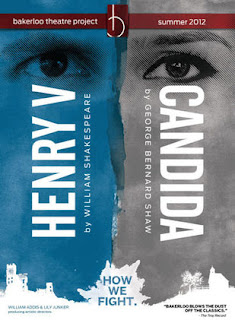It has taken me a while to make a post about Bakerloo Theatre Project's first Pittsburgh season because it has taken me some time to separate what I actually knew when I was buying my ticket and what I took from the performance. This is both a good thing and a thing of questionable worth. What I have learned is that my experience as an audience member of Henry V was entirely altered by one specific reference in the program.
When I go see a play my friend has produced, directed, starred in, or whatever (which is not the case with Henry V) they always ask me my opinion or if I "liked" it. To which I always respond emphatically "It was a play!" -- regardless of the caliber of the performance. This is because I currently believe that is the hardest part of making theatre: just making something a play, making something whole, something that makes sense.
Henry V was a play! It was thought out, able to be followed, and the same from start to finish.
I won't lie, it was murky at times. It seemed that the cast of respectably young actors felt that the weight of the words would carry the play itself, rather than taking the next step to making those words work for the actors. Words are weapons -- and, as the maker board in the lobby of Future Tenant Art Space read on the night of the performance, "What do you fight for?"
Prior to the performance I read the program. There is a sentence that reads, "This production was inspired by a traveling memorial called Eyes Wide Open." I thought that was great. One, the show was inspired. Two, it was relevant and playing on contemporary ideas. And three, they had the balls to tell us where they stole their ideas from.
This is the line that changed my view of the entire evening.
For those of you who don't know Eyes Wide Open is an exhibit created by American Friends Service Committee (Quaker values in action!) that travels the world showing numerous pairs of arranged combat boots that represent every U.S. casualty in the Iraq War. The coolest picture is of course from the nation's capital and I've included it below:
At the end of the play the boots as symbols shed a thematic light back on the rest of the performance. On paper there is a cast of 25+ in Shakespeare's Henry V. Bakerloo had a cast of 6. At the beginning of the play the actors stepped into the boots one by one, and at the end they left them in the same way. Considering the cast-size, the double/triple/quadruple casting and the "team-of-players" directorial approach, this invention suggested that these were the voices of the solders who died. The stories untold. The words we should have heard. The reason the boots are no longer filled.
Despite these same tactics fogging up the characters and occasionally the plot, I allowed the play to become a contemporary commentary on war, which would not have happened at all without the bit from the program. Without the program, the play contained nothing to suggest a contemporary debate. It was essentially a straightforward delivery of the text, with the opposing sides of the war played by the same characters who merely suggested sides by changing the color of their armbands and knocking over an empty trunk.
The most interesting experience I had as an audience member was during Act IV; Scene I. During this scene the king goes in disguise to talk to the soldiers of the war. During this scene the king and the soldiers banter back and forth questioning the worth of the king and the validity of his declarations of war. They ask if the king be immoral in his pursuits are we the soldiers immoral as well. They question who is to blame and at what cost.
As an audience member having read the program this became the most fascinating scene where the voices of the soldiers who presumably paid the ultimate wartime price and once owned the boots set up at the beginning and end of the play are given the chance to express their concerns and directly show me a conversation the dead might have with those in power during wartime.
As I mentioned before this is both a good thing and a thing of questionable worth. It was a great experience to have as an audience member, but how might it have been achieved without the use of an insert in the program? That my question for the bold members of Bakerloo Theatre Project and I believe that even without my blogpost they will grow to answer this question on their own.


No comments:
Post a Comment